What is it dermatitis herpetiform?
Dermatitis herpetiformis is a rare but persistent immunobullous disease that has been linked to celiac disease (the American spelling is celiac), a gluten-sensitive enteropathy.
The name herpetiform is derived from the tendency for blisters to appear in groups, similar to herpes simplex. However, dermatitis herpetiformis it is not due to viral infection.
Herpetiform dermatitis It is also known as Duhring-Brocq disease.
Who gets dermatitis herpetiformis?
- Herpetiform dermatitis It predominantly affects Caucasians 15 to 40 years old, but can occur in young or old and other races.
- There is a 2: 1 male to female ratio.
- More women under the age of 20 are affected than men.
- There's a genetic predisposition with an association with humans White blood cell antigens (HLA) DQ2 and DQ8.
- Some patients have a personal or family history of others autoimmune diseases like thyroid disease, pernicious anemia, type 1 diabetes, vitiligo, Addison's disease and alopecia areata.
What causes dermatitis herpetiformis?
- reherpetiform dermatitis and celiac disease are due to intolerance to the gliadin fraction of gluten found in wheat, rye, and barley.
- Gluten triggers IgA production antibodies and an autoimmune process that targets the skin and intestine.
- In celiac disease, gluten causes the intestine inflammation resulting in diarrhea, tiredness, weight loss, and abdominal discomfort.
- Most (> 90%) of patients with dermatitis herpetiformis They also have gluten sensitive enteropathy. Gastrointestinal symptoms can be mild to severe; some patients remain symptom-free.
- About 15-25% of celiac patients have concurrent dermatitis herpetiformis. These patients tend to have a more severe intestine. pathology compared to those with mainly dermatitis herpetiformis.
What are the clinical features of herpetiform dermatitis?
- reherpetiform dermatitis have a symmetrical distribution.
- Injuries most often appear on the scalp, shoulders, buttocks, elbows, and knees.
- It is characterized by prurigo (extreme itching papules) and vesicles on normal or reddened skin.
- They often appear in groups or serpiginous bunches
- The blisters often erode and form crusts due to immediate scratching.
- reherpetiform dermatitis It can also be presented initially as digital petechiae.
- Flat, thickened red spots plates and cure can occur similar to another inflammatory skin conditions such as dermatitis, scabies and papular urticaria.
- Injuries resolve to leave post-inflammatory hypopigmentation and hyperpigmentation.
Herpetiform dermatitis
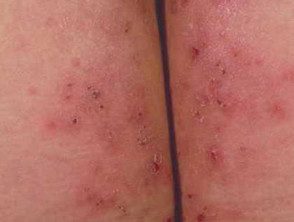
Herpetiform dermatitis
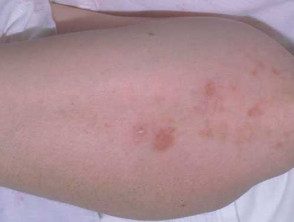
Herpetiform dermatitis
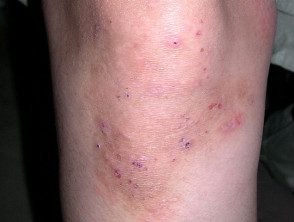
Herpetiform dermatitis
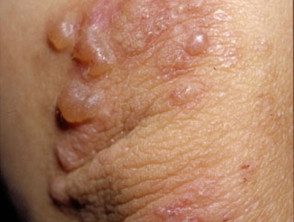
Herpetiform dermatitis
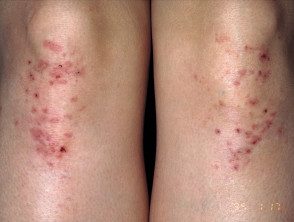
Herpetiform dermatitis
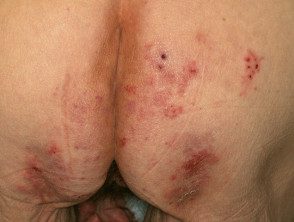
Herpetiform dermatitis
What are the complications of dermatitis herpetiformis and celiac disease?
The following conditions may affect patients with dermatitis herpetiformis, especially when associated with celiac disease:
-
Aphthous ulcers and angular cheilitis
-
Dry skin, nails and hair abnormalities
- Dental problems: fine enamel
- Neurological problems: ataxia (loss of balance), polyneuropathy, epilepsy
- Heart problems: pericarditis and cardiomyopathy
- Recurrent miscarriages (miscarriage)
- Fatty liver resulting in abnormal liver function tests
- * No Hodgkin lymphoma (NHL) * that affects the intestines or any part of the body
* NHL risk increases between dermatitis herpetiformis Patients Strict adherence to the gluten-free diet reduces this rare but serious complication in the long term.
How is dermatitis herpetiformis diagnosed?
Skin biopsy
Skin biopsy is usually necessary to confirm dermatitis herpetiformis. Characteristic histological appearances of dermatitis herpetiformis They are:
- Subepidermal blisters
- Neutrophils and eosinophils inflammatory cells in dermal papillae
- Granular IgA deposits in the dermal papillae by direct contact immunofluorescence
Detection of nutritional deficiencies.
Patients with dermatitis herpetiformis They are commonly offered the same blood tests that are used for celiac disease patients to detect nutritional deficiencies. These include:
- Complete blood count, liver function tests, and serum calcium
- Iron, zinc, vitamin B12 and folic acid.
- Thyroid function tests
Mild anemia can be caused by iron or folic acid deficiency (or both) due to malabsorption associated with gluten-sensitive enteropathy. Thyroid function tests are generally recommended because of the association between dermatitis herpetiformis and thyroid disease.
Diagnostic blood test
Specific autoantibody tests for dermatitis herpetiformis They are:
- IgA anti-endomysial antibodies
- IgA tissue transglutaminase antibody, tTG
- * IgA epidermal antibodies to transglutaminase, eTG (when available)
- Gliadin deamidated IgA and IgG peptide antibody, dGP
- Gliadin IgA and IgG Assay
- Total IgA level
* *Herpetiform dermatitis It is associated with IgA antibodies directed against epidermal transglutaminase (eTG), which is not the case in celiac disease.
Limiting results can be difficult to interpret.
Small intestine biopsy
- Herpetiform dermatitis Patients with abnormal blood results generally undergo a biopsy of the small intestine to confirm gluten-sensitive enteropathy.
- This is histologically characterized by the downy small intestine atrophy. This means that instead of being very complicated, the lining of the intestines is smooth and flattened.
- The intestine may appear normal due to treatment (gluten-free diet and / or medication), omission injuries (the sample was taken from an unaffected site), or the intestine may not be affected by the disease.
Other tests
HLA haplotype, a set of DNA variations, tests can reveal HLA-DQ2 or HLA-DQ8. This is present in almost all patients with dermatitis herpetiformis (and celiac disease).
What is the treatment for dermatitis herpetiformis?
Gluten free diet
A lifelong gluten-free diet is strongly recommended in patients with dermatitis herpetiformis, such as:
- Reduces medication requirement to control dermatitis herpetiformis
- Improves associated gluten associated enteropathy
- Improves nutrition and bone density.
- May reduce the risk of developing other autoimmune diseases
- It can reduce the risk of intestinal lymphoma.
Medicine
Dapsone is the treatment of choice for dermatitis herpetiformis, since it generally reduces itching in 3 days.
- The dose varies from 25 mg to 300 mg daily.
- Dapsone has possible side effects and monitoring requirements
- Can be gradually weaned in those who have been on a stable gluten-free diet
If you are intolerant or allergic to dapsone, the following may be helpful:
- Ultra powerful current steroids
- Systemic steroids
- Sulfapyridine (not available in New Zealand)
- Rituximab
What is the result for dermatitis herpetiformis?
Herpetiform dermatitis generally has a good forecast, with most patients responding well to a strict gluten-free and medication-free diet. The response rate varies between individuals (days to years).
